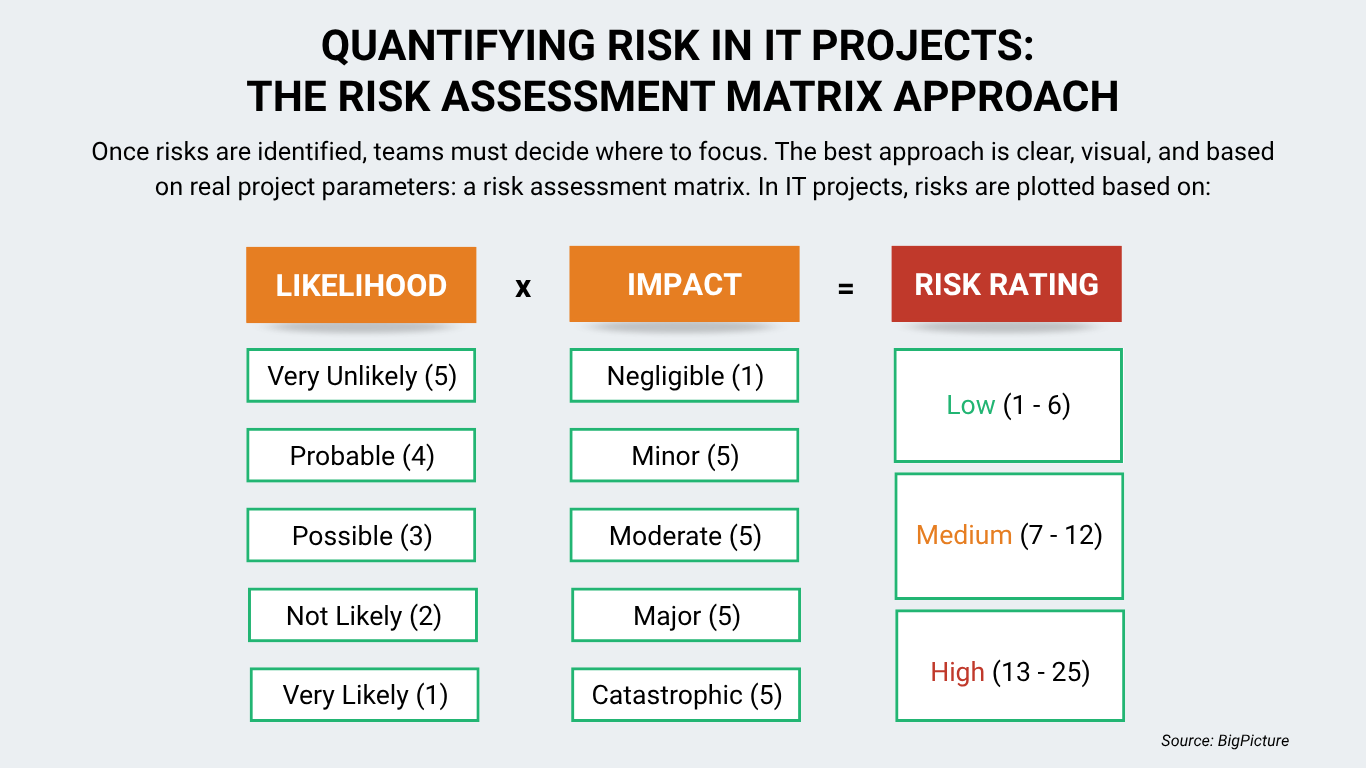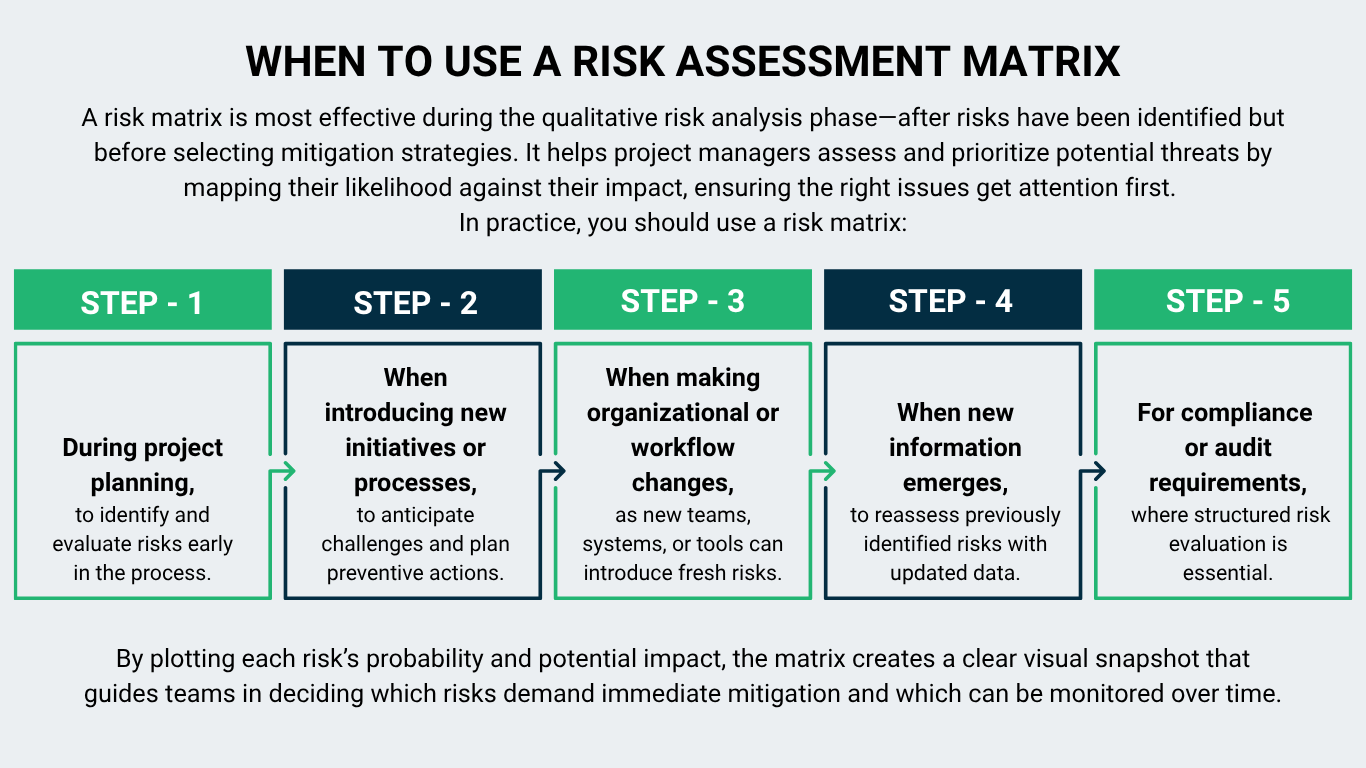
Quick Summary: In a world where project volatility is common, leaders can’t afford to react to risks; they need to anticipate them. The traditional risk assessment matrix has long guided project management, but its static design often limits foresight. This article reimagines it as a dynamic, data-driven framework powered by predictive intelligence—turning risk management from a reactive checklist into a proactive discipline. In today’s complex environments, resilience is about anticipating them before they emerge.
What’s the Best Way to Prioritize Risks in Complex Projects?
In an ideal world, every project would proceed exactly as planned. But in reality, uncertainty is the only certainty. For project leaders, the key to success isn't clairvoyance; it's proactive risk management. At the heart of any robust project risk management process lies a fundamental tool: the risk assessment matrix.
Every project carries risk, some visible, others concealed beneath the surface. While a project may occasionally progress seamlessly, uncertainties can often derail even the best-laid plans.
A risk matrix, a visual framework, enables teams to transition from reactive firefighting to strategic, forward-thinking governance. Furthermore, it brings structure to project uncertainty by mapping the likelihood and impact of potential threats in a clear, visual grid. By systematically evaluating and prioritizing potential threats and opportunities, you can allocate resources effectively, safeguard your project's objectives, and dramatically increase its chances of success.
This comprehensive guide will not only show you how to create and use a risk matrix but also how to transform it from a static document into a dynamic, predictive asset with the help of modern solutions, such as a predictive project management platform. When powered by modern data and intelligence, risk management shifts from a periodic task to an ongoing, high-precision practice.
What Is a Risk Assessment Matrix?
A risk assessment matrix (also known as a Probability and Impact Matrix) is a simple yet powerful tool for bringing structure and clarity to project risk analysis. It evaluates the likelihood and severity of risks during the planning phase, transforming subjective concerns into objective insights that drive confident, data-informed decisions.
Think of it as a project manager's strategic map. Instead of viewing all risks as equally threatening, the matrix allows you to categorize them, providing immediate clarity on where to focus your attention and resources. This structured approach transforms a daunting list of potential problems into a manageable action plan, ensuring that you not only identify risks but also actively manage them based on their true significance to the project's health.
Why does it work for your projects
- Instant Clarity: Makes complex risk data communicable in one view.
- Focus: Channels limited attention and budget to the highest-value mitigations.
- Consistency: Standardizes how teams score and compare risks across portfolios.
As the Project Management Institute (PMI) emphasizes, effective risk management is crucial for minimizing disruptions and enhancing project outcomes. Rather than diluting focus across every potential issue, this risk matrix empowers project leaders and teams to prioritize tasks and risks precisely, concentrating their efforts where they matter most.
When clarity meets structure, confidence follows. But beyond prioritizing risks, what does this framework truly offer to teams striving for project certainty?
Identifying risks is good. But what if you had a system that saw trouble before it formed—and told you exactly what to do next? Discover how TrueProject provides predictive clarity for risk and performance here.
What Are the Benefits of a Risk Assessment Matrix?
A risk assessment matrix is a decision-making compass that helps organizations act with foresight rather than hindsight. By bringing structure, visibility, and strategy into one framework, it transforms how teams perceive and manage uncertainty.
Here are some benefits of a risk assessment matrix:
- Clearer decisions through visual clarity: A risk matrix distills complex scenarios into a visual map, allowing teams to instantly identify which risks demand urgent attention and which can be monitored over time. This clarity fuels faster, more informed decisions and ensures that resources are directed where they matter most.
- Stronger communication and shared understanding: Risk discussions often get lost in translation across departments. The matrix bridges that gap, offering a common language for risk. It fosters collaboration, aligns perspectives, and promotes open dialogue—turning risk management into a collective responsibility rather than an isolated function.
- Smarter preparation for the unexpected: No project runs entirely as planned. The real strength of a risk assessment matrix lies in its ability to help teams prepare for uncertainty. By assessing likelihood and impact, organizations can create actionable contingency plans, ensuring that when challenges arise, responses are immediate, strategic, and effective.
- Proactive risk mitigation and resilience: Understanding potential threats before they strike means fewer surprises and smoother recoveries. A matrix empowers teams to reduce or neutralize the impact of identified risks, strengthening an organization’s ability to withstand disruption and maintain stability even under pressure.
- Prioritization that keeps teams on track: When multiple risks surface simultaneously, prioritization becomes critical. A risk assessment matrix helps teams rank these risks by severity and probability, ensuring focus remains on issues that could have the most significant influence on project success. This prioritization keeps efforts streamlined, outcomes predictable, and objectives within reach.

The benefits are clear. But how do you translate this framework from theory into action? It starts with building a matrix that reflects both the likelihood and impact of every potential risk.
How to Build a Risk Assessment Matrix Template
Creating a risk assessment matrix begins with defining two essential dimensions: severity and likelihood. These criteria help categorize each risk and guide your prioritization efforts.

Step 1: Define Your Severity Scale (Columns of the Matrix)
The severity scale outlines the level of impact a risk could have on your project. In a 5×5 matrix, you’ll use five levels to assess this:
- Negligible (1): Minimal or no disruption; easily absorbed.
- Minor (2): Slight inconvenience; manageable without significant resource shifts.
- Moderate (3): Noticeable impact requiring time and effort to resolve.
- Major (4): Serious consequences affecting scope, timeline, or budget.
- Catastrophic (5): Severe, long-lasting damage; potential project failure.
Step 2: Define Your Likelihood Scale (Rows of the Matrix)
This scale measures how probable it is that a risk will occur:
- Very Unlikely (1): Rare chance of happening.
- Not Likely (2): Uncommon, but not impossible.
- Possible (3): Could happen under certain circumstances.
- Probable (4): Likely to happen based on experience or trends.
- Very Likely (5): High probability; expected at some point.
Step 3: Calculate and Categorize Risk Impact
Once you’ve assigned severity and likelihood ratings, multiply the two to find the risk impact score (ranging from 1 to 25). This value determines the overall threat level and can be color-coded for clarity:
- Low Risk (1–6): These are unlikely and low-impact risks. Monitor them, but assign low priority.
- Medium Risk (7–12): These risks could cause disruptions but can often be mitigated with early planning.
- High Risk (13–25): These are critical threats. They’re likely to occur and could significantly affect project success. Prioritize them in your risk management strategy.
Designing your matrix is step one. Using it to drive smarter, risk-based decisions is where transformation begins.
A static matrix won’t protect your project. TrueProject will. See it in action. Book your demo and discover how TrueProject transforms risk visibility into effective risk control.
How to Use a Risk Assessment Matrix
A risk assessment matrix empowers you to transition from uncertainty to control, enabling teams to view risks not as roadblocks but as valuable insights. Once you’ve created a matrix, it becomes a reusable framework that serves as your guide for analyzing and prioritizing potential threats across any project or portfolio.
Follow these five steps to move from theoretical risk to confident control.
1. Identify Potential Risks: Start by listing every possible threat that could affect your project—budget issues, timeline delays, resource shortages, or technical failures. Gather input from different stakeholders to capture a complete picture. Utilize brainstorming tools, such as mind mapping, to ensure that nothing slips through. The goal is to create a comprehensive risk register that accurately reflects reality, rather than assumptions.
2. Define Risk Criteria: Next, establish the criteria for measuring each risk. A matrix typically rates two things: likelihood (how likely it is to happen) and impact (how severe the outcome could be). Create precise scales, such as 1 to 5 or low to high, that your team can apply consistently across all risks.
3. Assess Likelihood and Impact: Evaluate every risk using those scales. Review past project data, consult with your team, and ask: Has this issue occurred before? How often? What was the result? Assign each a score for likelihood and impact. This simple, structured approach replaces assumptions with evidence.
4. Calculate the Risk Score: Now, multiply likelihood by impact to get each risk’s score. This provides a quick, visual way to identify which issues pose the greatest threat. High scores go in the top-right corner of your matrix—the “act now” zone. Lower scores fall in the “monitor and manage” category.
5. Prioritize and Act: Once your risks are plotted, it’s time to respond.
- Mitigate: Take steps to reduce the probability or impact.
- Transfer: Shift responsibility, like through insurance or outsourcing.
- Accept: Monitor low-risk issues without requiring heavy intervention.
- Avoid: Change course to eliminate the threat.
This prioritization ensures that energy and resources are allocated where they’ll make the most significant difference.
6. Review and Reassess: Risk management is ongoing. As your project evolves, revisit your matrix to reflect new realities. Regular reviews keep your insights fresh and your team prepared for what’s next.
The matrix sharpens foresight—but it’s not foolproof. Before relying on it entirely, it’s vital to recognize the challenges that come with it.
You can’t afford reactive risk management. It’s time to replace delayed reactions with real-time control. Learn how TrueProject helps you see risk before it strikes.

What are the Challenges of the Risk Matrix?
While a risk matrix is a valuable tool for visualizing and prioritizing project risks, they do not provide a solution to all your project problems. Understanding these challenges helps teams use them wisely rather than relying on them blindly.
- Subjective assessments: Risk evaluation often depends on personal judgment. Since likelihood and impact are based on perception, two people might rate the same risk differently, making the overall assessment less reliable.
- Misguided decisions: When risks are incorrectly categorized, the matrix can paint a misleading picture. This may result in poor prioritization or the misallocation of resources, leading to decisions that fail to address the real threats.
- No sense of timing: A matrix typically doesn’t distinguish between short-term and long-term project risks. Whether a threat might occur next week or two years from now, both appear identical, making it harder to plan for time-sensitive risks.
- Oversimplification of complex risks: Real-world risks are dynamic and interconnected. A static matrix can oversimplify this complexity, ignoring how quickly a minor issue can escalate or how one risk can trigger another.
But the real problem isn’t just what the matrix can’t do; it’s how it’s often misused, sidelined, or stripped of its strategic value in day-to-day project execution. A static matrix can only take you so far. To stay ahead of risk, you need systems that sense, learn, and adapt in real-time; long before issues arise.
How Can Predictive Intelligence Make Your Risk Matrix More Accurate?
Traditional matrices are rear-view and reflect what teams already know. To move earlier and faster, you need forward signals. That’s where an AI-powered project management solution comes in. The project management solution doesn’t replace the matrix; instead, it redefines how it’s populated, updated, and used.
Intelligent systems surface risks early by tapping into ongoing and historical project data, such as task updates, milestone variances, team behavior, and stakeholder sentiment. They don’t wait for visible impact; they detect the precursors.
This enables real-time adjustments to risk scores, even between formal reviews. It also reveals patterns human teams may overlook—recurring risks across similar projects, emerging issues tied to specific vendors, or declining sentiment that typically precedes delivery delays.
With predictive intelligence in place, the matrix becomes a living model. There are no more manual updates or delayed insights. Every risk is contextual, weighted, and grounded in real-time behavior. When paired with real-time dashboards, the risk assessment matrix supports both strategic and operational needs, enabling project leaders to steer the portfolio while managers manage project work.
Why It Matters Now More Than Ever
Today’s project environments are less forgiving. A delay in one workstream can ripple across the entire project delivery chain. Regulatory scrutiny is tighter, margins are thinner, and customers expect more transparency.
Predictive intelligence enables organizations to move faster, act earlier, and protect their project outcomes. It transforms the matrix into a decision-support tool, not just a visual aid.
Leaders no longer wait for risk workshops. They see changes as they happen, focus on real threats rather than perceived ones, and build resilience not just into individual projects but across the entire portfolio. Predictive insights give you foresight. But what if you could turn that foresight into instant, decisive action? That’s where the future of risk management truly begins.
Risk Assessment Matrix: You Don’t Need Another Dashboard. You Need Real-Time Control

Delays catch you off guard. Dependencies slip through unnoticed. Risks escalate silently until it’s too late. The problem isn’t a lack of planning; it’s the false confidence that nothing will go wrong. Static risk logs and outdated risk assessment matrices give a false sense of control. They miss timing, context, and momentum. You don’t just need to identify risks—you need to anticipate them before they trigger disruption.
This is where risk assessment matrix frameworks fall short. They freeze risk in time. By the time you reassess, the damage is already underway. Project leaders need clarity in motion, a dynamic approach to scoring, rescore, and responding based on live project behavior.
TrueProject, a KPI-based predictive project management SaaS solution, delivers precisely that. It fuses your risk assessment matrix with real-time predictive intelligence. Every stakeholder sentiment, missed update, or milestone drift feeds into a continuously evolving risk profile. You’re not guessing—you’re acting with foresight and no longer relying on lagging indicators or manual reviews. With TrueProject, risk visibility becomes proactive, decisions become data-driven, and threats lose their power to surprise.
Real control isn’t about tracking risks. It’s about anticipating them. Experience TrueProject Snapshot and get an instant, in-time view of project performance, alignment, and emerging risks.
Frequently Asked Questions (FAQs)
Q1: What is the primary purpose of a risk assessment matrix?
The primary purpose of a risk assessment matrix is to provide a visual, systematic method for prioritizing project risks based on their probability of occurrence and potential impact on objectives. This allows project teams to focus their attention and resources on the most significant threats and opportunities.
Q2: What is the difference between a 3x3 and a 5x5 risk matrix?
The difference lies in the level of detail. A 3x3 matrix (with three levels for probability and impact) is simpler and faster to use but offers less granularity. A 5x5 risk matrix provides more nuanced categorization, allowing for finer distinctions between risk levels, which is better suited for complex projects.
Q3: How often should a risk assessment matrix be updated?
A risk matrix should be a living document. It must be reviewed and updated regularly—typically at key project milestones, during monthly status reviews, or whenever a significant change occurs in the project's scope, schedule, or environment.
Q4: Can a risk matrix be used for positive risks (opportunities)?
Absolutely. The same framework applies. An opportunity with a high probability of occurring and a high positive impact (e.g., finishing early or under budget) would be a high-priority item that you should actively work to exploit.
Q5: How does software like TrueProject enhance a traditional risk matrix?
TrueProject enhances the traditional risk matrix by integrating predictive analytics. It uses historical and current project data to provide objective validation for probability and impact scores, identifies emerging risks through trend analysis, and offers predictive health scores, turning the static matrix into a dynamic, intelligent early-warning system.






